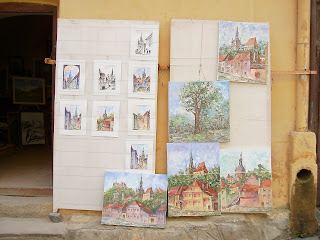Sighişoara, Romania
Sighişoara is a perfectly preserved medieval town in Transylvania. The medieval citadel is fortified with a 14th-century wall. The 14 towers and 5 artillery bastions were added a century later. Nine towers and 2 bastions remain along the intact city walls, which encircle sloping cobbled streets lined with 16th-century burgher houses and untouched churches. Today the citadel is a UNESCO World Heritage site.
 The Clock Tower is 64 meters tall with base walls as large as 2.35 meters thick. Inside the 1648 clock is a pageant of figurines, each representing a character from the Saxon pantheon: Peace bears an olive branch, Justice has a set of scales and Law wields a sword. The executioner is also present and the drum-player strikes every hour.
The Clock Tower is 64 meters tall with base walls as large as 2.35 meters thick. Inside the 1648 clock is a pageant of figurines, each representing a character from the Saxon pantheon: Peace bears an olive branch, Justice has a set of scales and Law wields a sword. The executioner is also present and the drum-player strikes every hour. 
 There are also seven figures , each representing a day of the week.
There are also seven figures , each representing a day of the week.

 A lot of crafters were inside the citadel in Piaţa Cetăţii (Castle Square). In the Square, markets, craft fairs, public executions and witch trials were held. In 1603, a nobleman was tried in the square in front of 12 judges for high treason. He was found guilty and had his right hand chopped off before being impaled.
A lot of crafters were inside the citadel in Piaţa Cetăţii (Castle Square). In the Square, markets, craft fairs, public executions and witch trials were held. In 1603, a nobleman was tried in the square in front of 12 judges for high treason. He was found guilty and had his right hand chopped off before being impaled.  Settled by the Romans, the town was first documented in 1280. Saxon colonists settled here from the 12th-century onwards. It is still populated by Romanian-born Germans. The building below is the Primaria (City Hall).
Settled by the Romans, the town was first documented in 1280. Saxon colonists settled here from the 12th-century onwards. It is still populated by Romanian-born Germans. The building below is the Primaria (City Hall). The Church of the Dominican Monastery is from the 15th-century. The Gothic church became the Saxons' main Lutheran church in 1556.
The Church of the Dominican Monastery is from the 15th-century. The Gothic church became the Saxons' main Lutheran church in 1556. The Roman Catholic Church from 1894. The Saxon community also has one more Lutheran Church outside the citadel walls which was used in the 17th-century as an isolation compound for victims of the plague and later leprosy. Many people were taken here and to the "leprosarium" where as many as 38 people died every day.
The Roman Catholic Church from 1894. The Saxon community also has one more Lutheran Church outside the citadel walls which was used in the 17th-century as an isolation compound for victims of the plague and later leprosy. Many people were taken here and to the "leprosarium" where as many as 38 people died every day. Other towers included the Goldsmiths, Tailors, Carpenters, and Tinsmiths. They were the only craftsmen to have their guilds and workshops inside the citadel. Together they built eight fountains within the city walls to ensure a continuous flow of water supply during times of siege.
Other towers included the Goldsmiths, Tailors, Carpenters, and Tinsmiths. They were the only craftsmen to have their guilds and workshops inside the citadel. Together they built eight fountains within the city walls to ensure a continuous flow of water supply during times of siege.






 That is Vlad above and below is his birth home. He reportedly lived here from 1431 when he was born until he was 4. The Dracul House is complete with its original river-stone floor and is now a restaurant.
That is Vlad above and below is his birth home. He reportedly lived here from 1431 when he was born until he was 4. The Dracul House is complete with its original river-stone floor and is now a restaurant. 



 Cristian is down there in the middle. He climbed to the top the year before and was feeling a bit lazy in the heat to do it again.
Cristian is down there in the middle. He climbed to the top the year before and was feeling a bit lazy in the heat to do it again.



















0 Comments:
Post a Comment
<< Home